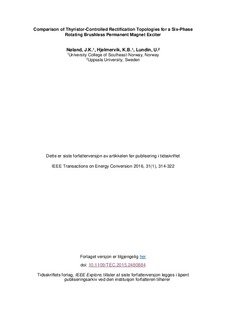| dc.contributor.author | Nøland, Jonas Kristiansen | |
| dc.contributor.author | Hjelmervik, Karina Bakkeløkken | |
| dc.contributor.author | Lundin, Urban | |
| dc.date.accessioned | 2015-11-13T09:48:44Z | |
| dc.date.accessioned | 2017-10-02T13:12:00Z | |
| dc.date.available | 2015-11-13T09:48:44Z | |
| dc.date.available | 2017-10-02T13:12:00Z | |
| dc.date.issued | 2016 | |
| dc.identifier.citation | IEEE transactions on energy conversion 2015, 31(3) | nb_NO |
| dc.identifier.issn | 0885-8969 | |
| dc.identifier.uri | http://hdl.handle.net/11250/2457759 | |
| dc.description.abstract | The thyristor bridge rectifier has proven to be a reliable solution regarding control of excitation equipment for synchronous generators. However, in rotating brushless exciters the diode rectifier is the dominant topology on the shaft. In order to improve the step response of rotating exciters, one could put a thyristor bridge rectifier on the rotating part and control the firing angle remotely from a stationary controller. This paper compares different multiphase configurations of permanent magnet synchronous machines as a rotating exciter and the possibility to reduce the torque ripple by selecting the appropriate rectification topology. The paper also explains the implications of the self and mutual inductances of the armature windings for the performance of the exciter. | nb_NO |
| dc.language.iso | eng | nb_NO |
| dc.title | Comparision of Thyristor-Controlled Rectification Topologies for a Six-Phase Rotating Brushless Permanent Magnet Exciter | nb_NO |
| dc.type | Journal article | nb_NO |
| dc.type | Peer reviewed | |
| dc.date.updated | 2015-11-13T09:48:44Z | |
| dc.description.version | acceptedVersion | nb_NO |
| dc.source.pagenumber | 314-322 | nb_NO |
| dc.source.volume | 31 | nb_NO |
| dc.source.journal | IEEE transactions on energy conversion | nb_NO |
| dc.source.issue | 1 | nb_NO |
| dc.identifier.doi | 10.1109/TEC.2015.2480884 | |
| dc.identifier.cristin | 1288737 | |
